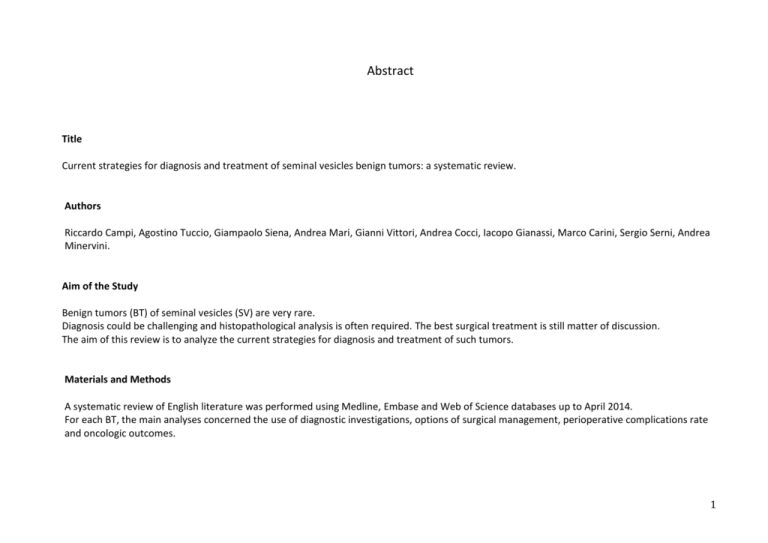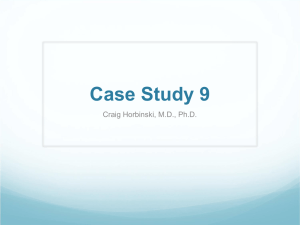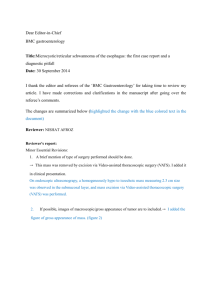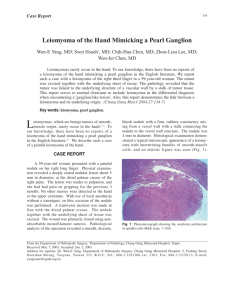Abstract Title Current strategies for diagnosis and treatment of
advertisement

Abstract Title Current strategies for diagnosis and treatment of seminal vesicles benign tumors: a systematic review. Authors Riccardo Campi, Agostino Tuccio, Giampaolo Siena, Andrea Mari, Gianni Vittori, Andrea Cocci, Iacopo Gianassi, Marco Carini, Sergio Serni, Andrea Minervini. Aim of the Study Benign tumors (BT) of seminal vesicles (SV) are very rare. Diagnosis could be challenging and histopathological analysis is often required. The best surgical treatment is still matter of discussion. The aim of this review is to analyze the current strategies for diagnosis and treatment of such tumors. Materials and Methods A systematic review of English literature was performed using Medline, Embase and Web of Science databases up to April 2014. For each BT, the main analyses concerned the use of diagnostic investigations, options of surgical management, perioperative complications rate and oncologic outcomes. 1 Results 58 case reports have been published in literature on BTs of SVs. Of these, 5 were excluded from the analysis due to lack of data. Cystoadenoma was found in 20 cases (38%), leiomyoma in 10 (19%), schwannoma in 8 (15%), mixed epithelial-stromal tumor in 5 (9%), phyllodes tumor in 4 (8%) and other BTs in 6 (11%). Median patient age and median tumor diameter were 50 years (range 23-79) and 5.0 cm (range 2,0-29,0), respectively. In 34 papers (64%) the diagnostic work-up was described. In these studies, ultrasound (US) was used in 19 cases (56%), CT scan in 23 (68%), endorectal MRI in 20 (59%), preoperative biopsy in 17 (50%) and intraoperative biopsy in 1 case (3%). Explorative laparotomy was carried out in 5 cases (15%), while cystoscopy and other modalities in 3 (9%); finally, 2 cases (6%) were found at the time of autopsy. In 51 studies (96%) the surgical technique was well defined. An open approach was used in most cases, with conservative tumorectomy in 26 cases (51%) and radical cysto-prostato-vesiculectomy in 6 (12%). Laparoscopic and robotic seminal vesiculectomy (SVe) were performed in 17 (33%) and 2 (4 %) cases, respectively. No perioperative complications were reported in the published series. Local recurrence occurred in 3 cases (6%). The period of follow up was highly variable among the studies. Discussion The first priority during the diagnostic assessment of SVs BTs is to rule out primary or secondary malignancies. The overall preoperative evaluation is critical to choose the more appropriate surgical treatment. Analyzing the literature, MRI and preoperative biopsy are the most useful diagnostic investigations. MRI accurately defines the anatomic relationships of the tumor, while biopsy the characterization of its nature and consequently the more appropriate surgical strategy. SVe is the recommended treatment for solid masses that are benign on biopsy, if symptomatic. Although most cases in literature were managed with open surgery, laparoscopic or robotic SVe is a minimally invasive approach with excellent oncologic outcomes. Conclusions MRI and preoperative biopsy are fundamental in the diagnostic work-up for BTs of SVs. Minimally invasive SVe could be considered the gold standard treatment, although the overall Grade of Recommendation is currently low, as the evidence is still based on case reports and sporadic case series. 2 Table 1. Overview of the 53 published series on Benign Tumors of Seminal Vesicles included in the analysis. Histopathological Definition (according to the Number of studies, Patient Age (years), study) Cystoadenoma n (%) median (Range) Tumor Size (greatest diameter) (cm), median (Range) Number of Studies with a Number of Studies with a precise precise definition of the definition of the therapeutic diagnostic strategy, strategy, n (%) n (%) 20 (38) 49 (23-64) 7.0 (3.0-17.2) 10 (50) 19 (95) 5 (9) 61 (37-70) 6,5 (2,5-29,0) 4 (80) 5 (100) Leiomyoma 10 (19) 61 (37-74) 5,0 (2,0-14,5) 7 (70) 9 (90) Phyllodes Tumor 4 (8) 43 (39-59) 7,6 (5,5-14,5) 3 (75) 4 (100) Schwannoma (Neurilemmoma) 8 (15) 45 (31-79) 3,0 (2,2-7,0) 5 (63) 8 (100) 6 (11) 55 (29,79) 5,8 (2,0-14,0) 5 (83) 6 (100) 53 (100) 50 (23-79) 5,5 (2,0-29,0) 34 (64) 51 (96) Mixed Epithelial - Stromal tumors (MEST) - low grade Others (Mammary-type myofibroblastoma, Paraganglioma, Cystomyoma, Low Grade Adnexal tumour of Wollfian origin, Solitary fibrous tumor) All tumors 3 Table 3.1 Use of diagnostic investigations in the published literature on Benign Tumors of Seminal Vesicles. Numbers and percentages are referred to those studies where a precise definition of the diagnostic work-up was clearly stated (see Table 1). (Legend : TRUS = transrectal Ultrasound; CT = computed tomography; MRI = Magnetic resonance imaging; CYS = cystoscopy; FNA = fine needle aspiration; Abd US = abdominal ultrasound). Histopathological Definition (according to the study) Ultrasound (TRUS +/- Abd US), CT, MRI, n Tumor biopsy, Intraoperative Biopsies, Explorative Laparotomy, Other strategies - Cystology, (Cystoscopy, FNA IV Urography, etc.), Autopsy, n (%) (%) n (%) n (%) n (%) 6 (60) 6 (60) 7 (70) 4 (40) 1 (10) 1 (10) 2 (20) 1 (10) 1 (25) 4 (100) 2 (50) 3 (75) 0 (0) 1 (25) 1 (25) 0 (0) Leiomyoma 3 (43) 4 (57) 4 (57) 2 (29) 0(0) 1 (15) 0 (0) 1 (15) Phylloides Tumor 2 (67) 2 (67) 2 (67) 1 (33) 0 (0) 1 (33) 0 (0) 0 (0) Schwannoma (neurilemmoma) 5 (100) 4 (80) 3 (60) 4 (80) 0 (0) 0 (0) 0 (0) 0 (0) 2 (40) 3 (60) 2 (40) 3 (60) 0 (0) 1 (20) 0 (0) 0 (0) 19 (56) 23 (68) 20 (59) 17 (50) 1 (3) 5 (15) 3 (9) 2 (6) Cistoadenoma Mixed Ephitelial - Stromal tumors (MEST) low grade n (%) n (%) n (%) Others (Mammary-type myofibroblastoma, Paraganglioma, Cystomyoma, Low Grade Adnexal tumour of Wolffian origin, Solitary fibrous tumor) All Tumors 4 Table 3.2 Use of different surgical treatments in the published literature on Benign Tumors of Seminal Vesicles. Numbers and percentages are referred to those studies where a precise definition of the surgical technique was clearly stated (see Table 1). Open - Conservative Histopathological Definition (according to the study) tumorectomy Open - Cysto-prostato- (with different vesiculectomy, approaches), n (%) n (%) Laparoscopic Robot - assisted Vesiculectomy laparoscopic vesiculectomy (LV), (RALV), n (%) n (%) Perioperative complications (Y= any complication reported; N = no Local Recurrence n (%) complications reported) Cistoadenoma 11 (58) 1 (5) 5 (26) 2 (11) N 2 (10) Mixed Ephitelial - Stromal tumors (MEST) low grade 2 (40) 2 (40) 1 (20) 0 (0) N 0 (0) Leiomyoma 5 (55) 1 (11) 3 (33) 0 (0) N 0 (0) Phylloides Tumor 2 (50) 0 (0) 2 (50) 0 (0) N 0 (0) Schwannoma (neurilemmoma) 2 (25) 1 (13) 5 (63) 0 (0) N 0 (0) 4 (67) 1 (17) 1 (17) 0 (0) N 1 (17) 26 (51) 6 (12) 17 (33) 2 (4) N 3 (6) Others (Mammary-type myofibroblastoma, Paraganglioma, Cystomyoma, Low Grade Adnexal tumour of Wolffian origin, Solitary fibrous tumor) All Tumors 5 Figure 1. Classes of Seminal Vesicles Benign Tumors in the published series according to histopathological analysis after surgical excision. Cystoadenoma Mixed Ephitelial - Stromal tumors (MEST) - low grade 11% 38% 15% Leiomyoma 8% Phylloides Tumor 19% 9% Schwannoma (Neurilemmoma) Others (Mammary-type myofibroblastoma, Paraganglioma, Cystomyoma, Low Grade Adnexal tumour of Wolffian origin, Solitary fibrous tumor) 6 Figure 2.1 Overview of diagnostic investigations performed for Benign Tumors of Seminal Vesicles in the published series. Percentages are referred to those studies where a precise definition of the diagnostic work-up was clearly stated (see Table 1). The analysis concerns all tumor histotypes. 56% Ultrasound 6% 9% Autopsy CT Other strategies 68% MRI 59% 15% Explorative Laparotomy Tumor biopsy 50% Intraoperative Biopsies 3% 7 Figure 2.2 Overview of surgical treatment options for Benign Tumors of Seminal Vesicles in the published series. Percentages are referred to those studies where a precise definition of the therapeutic strategy was clearly stated (see Table 1). The analysis concerns all tumor histotypes. 51% Open - Conservative tumorectomy 4% Robot - assisted laparoscopic vesiculectomy 12% Open - Cysto-prostatovesiculectomy Laparoscopic Vesiculectomy 33% 8 Figure 3.1. Differential use of each diagnostic modality for different tumor histotypes in the published series. 100% 95% 90% 85% 80% 75% 70% 65% 60% 55% 50% 45% 40% 35% 30% 25% 20% 15% 10% 5% 0% Ultrasound CT MRI Tumor biopsy Intraoperative Biopsies Explorative Laparotomy Other strategies (Cystoscopy, FNA - Cystology, IV Urography, etc) Autopsy Cystoadenoma Mixed Ephitelial Stromal tumors (MEST) - low grade Leiomyoma Phylloides Tumor Schwannoma (Neurilemmoma) Others (Mammary-type myofibroblastoma, Paraganglioma, Cystomyoma, Low Grade Adnexal tumour of Wolffian origin, Solitary fibrous tumor) 9 Figure 3.2. Differential use of each surgical technique for different tumor histotypes in the published series. 80% 75% 70% Open - Conservative tumorectomy 65% 60% 55% Open - Cysto-prostatovesiculectomy 50% 45% 40% 35% Laparoscopic Vesiculectomy 30% 25% 20% Robot - assisted laparoscopic vesiculectomy 15% 10% 5% 0% Cistoadenoma Mixed Ephitelial Stromal tumors (MEST) low grade Leiomyoma Phylloides Tumor Schwannoma (neurilemmoma) Others (Mammary-type myofibroblastoma, Paraganglioma, Cystomyoma, Low Grade Adnexal tumour of Wolffian origin, Solitary fibrous tumor) 10










